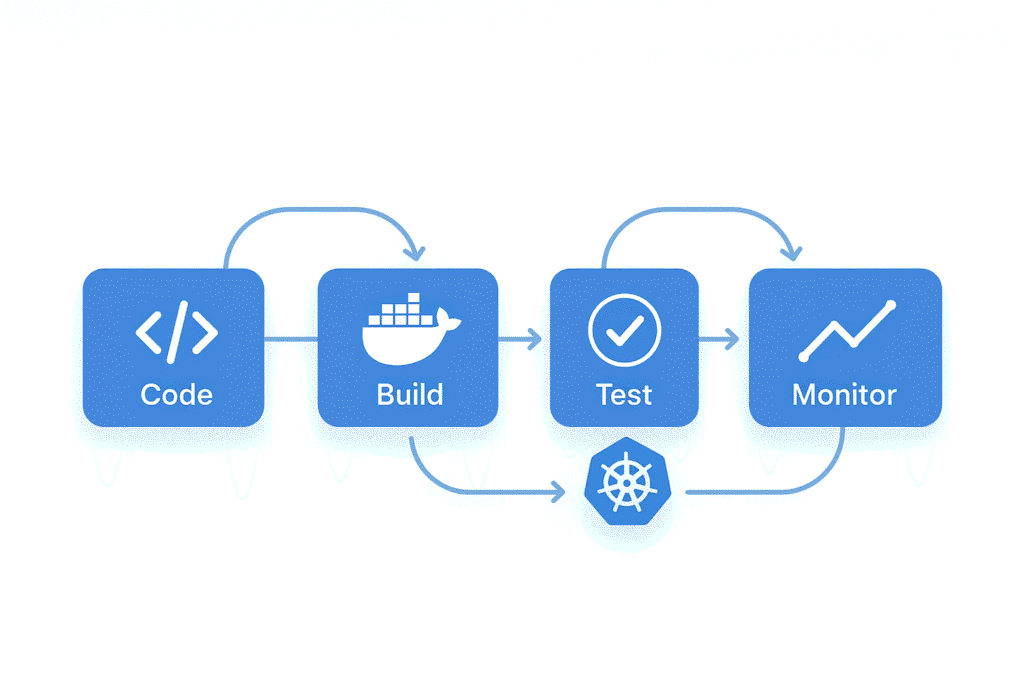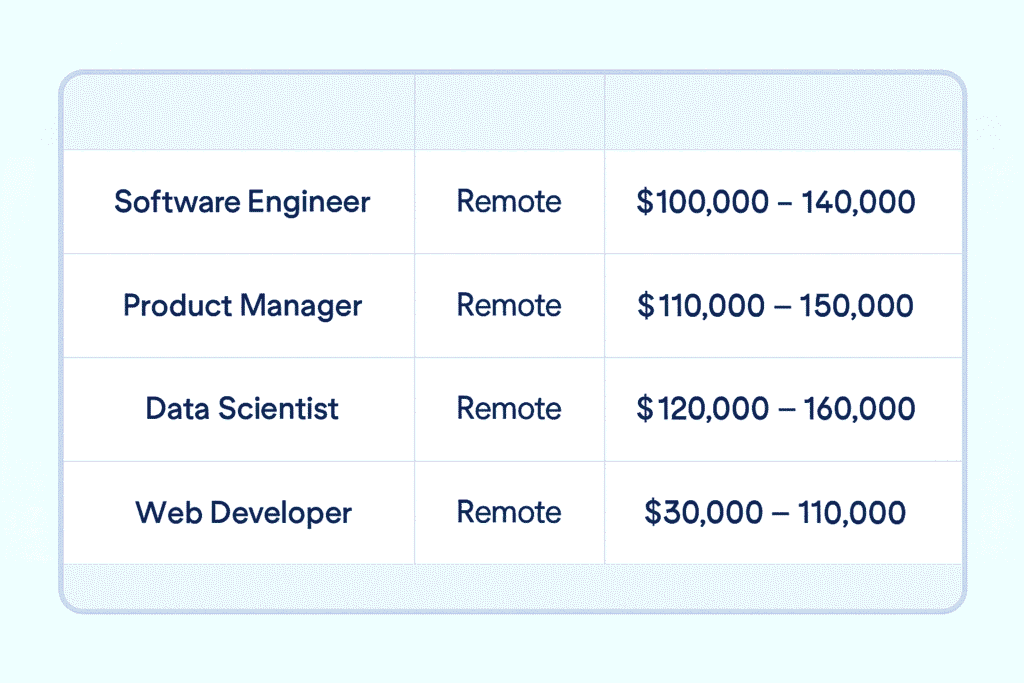The Remote Tech Job Revolution in the USA: Your Complete Guide
Table of Contents
- Introduction
- Why Remote Tech Jobs Are Booming in the USA
- Top Remote Tech Jobs Hiring Right Now
- Job Market Trends for Remote Tech Roles
- Best Websites to Find Remote Tech Jobs in the USA
- How to Stand Out in the Remote Job Market
- Salary Expectations for Remote Tech Jobs
- FAQs About Remote Tech Jobs in the USA
- Conclusion
Introduction
Imagine waking up, brewing your favorite coffee, and settling into your home office—no commute, no rigid schedules, just meaningful work on your terms. This isn’t a futuristic dream; it’s the reality for thousands of tech professionals across the USA right now.
The demand for remote tech jobs has exploded, reshaping the American workforce. Companies—from scrappy startups to Fortune 500 giants—are racing to hire skilled developers, data wizards, and cybersecurity experts who can work from anywhere. Why? Because the digital transformation wave isn’t slowing down, and neither is the need for top-tier tech talent.
Why This Matters to You
Whether you’re a seasoned software engineer tired of the office grind, a data scientist craving flexibility, or a cybersecurity specialist looking for better opportunities, the remote job market is brimming with possibilities. Salaries are competitive, roles are diverse, and the best part? You don’t need to relocate to land your dream job.
In this guide, we’ll break down:
- ✅ Why remote tech jobs are dominating the USA job market
- ✅ The hottest roles companies are hiring for right now
- ✅ Where to find these opportunities (Hint: it’s easier than you think.)
- ✅ Proven strategies to stand out in a competitive field
Looking for the highest-paying roles? Check out our deep dive into high-paying jobs in the USA for skilled workers.
The Rise of Remote Tech Work: More Than Just a Trend
A Permanent Shift, Not a Pandemic Blip
Remember when remote work was a temporary “perk” during lockdowns? Those days are long gone. Today, 68% of U.S. tech companies offer fully remote or hybrid positions—and that number keeps growing. Why?
- Employees demand flexibility—85% of tech professionals prefer remote or hybrid work.
- Employers save costs—no expensive office spaces = bigger budgets for salaries.
- Productivity rises—Remote IT teams frequently perform better than in-office ones, despite outdated stereotypes.
Who’s Hiring? (Spoiler: Everyone)
From Silicon Valley disruptors to East Coast finance giants, industries across the board are scrambling to secure remote tech talent. Roles in cloud computing, cybersecurity, AI, and software development are especially in demand.
What This Means for Your Career
If you have in-demand tech skills, you hold the power. Companies aren’t just offering jobs—they’re rolling out:
- ✨ Signing bonuses
- ✨ Flexible schedules
- ✨ Stock options & profit-sharing
- ✨ Fully paid home office setups
Pro Tip: Local opportunities still exist! If you prefer hybrid work, see our guide on where to find local job openings in my area, USA.
Your Next Step? Dive Into the Opportunities
The remote tech revolution is here, and it’s creating life-changing careers for those who know where to look. Ready to explore the top remote jobs hiring now? Let’s get started.
(Stay tuned—the next sections will reveal the highest-paying roles, salary benchmarks, and insider tips to land your ideal position.)
Why Remote Tech Jobs Are Booming in the USA

Let’s be honest—the traditional 9-to-5 office grind is becoming as outdated as floppy disks. Across America, a quiet revolution is transforming how tech professionals work, and it’s creating incredible opportunities for those ready to embrace it. Here’s why remote tech jobs aren’t just a temporary trend but the new normal in the USA’s job market.
1. The Freedom Revolution: Work From Anywhere (Seriously, Anywhere)
Gone are the days when “working from home” simply meant trading your office chair for a kitchen stool. Today’s remote tech revolution has unlocked something far more powerful—true location freedom that’s reshaping careers and companies alike.
For Tech Professionals: Your Office, Your Rules
Picture this:
- Writing Python scripts with your feet in the sand at a Bali co-working space
- Debugging React components from a mountain cabin with WiFi and a view
- In Costa Rica, holding standup meetings in between surf sessions
This isn’t fantasy—it’s the daily reality for thousands of tech professionals who’ve embraced remote work. The benefits go deeper than Instagram-worthy workspaces:
- ✔ No more wasted hours in traffic or crowded subways
- ✔ Design your ideal work environment (quiet home office or bustling café?)
- ✔ Align work with life—drop off kids, take midday hikes, and work when you’re most productive
For Companies: The Productivity Paradox
Contrary to old-school management fears, remote work actually boosts performance:
- Stanford research shows a 13% productivity increase for remote workers.
- Companies report 30% lower turnover with remote teams (Owl Labs 2024).
- 24/7 productivity across time zones means faster project completion.
The Win-Win That’s Here to Stay
Forward-thinking tech companies now compete on flexibility:
- Basecamp offers employees $5,000 to work remotely from anywhere.
- GitLab’s 1,300+ employees work across 67 countries—zero offices.
- Startups use remote work to attract talent away from Silicon Valley giants.
The bottom line? Whether you’re a developer, data scientist, or IT specialist, you now have unprecedented power to design a career that fits your life—not the other way around.
Ready to join the revolution? The next section reveals exactly which remote tech skills are most in demand right now…
2. The Talent Gold Rush: Companies Can’t Get Enough
The old Silicon Valley monopoly on tech talent is officially over. Companies have awakened to a game-changing truth: brilliant engineers and designers don’t just live within 20 miles of San Francisco.
The New Talent Map
- 🏙️ Pittsburgh’s Python prodigy now builds AI tools for an NYC startup.
- 🎸 Austin’s UX wizard crafts interfaces for a Boston SaaS company.
- 🍑 Atlanta’s cybersecurity guru protects a Chicago fintech firm.
This geographic liberation creates life-changing opportunities for skilled professionals outside traditional tech hubs—finally leveling the playing field.
By the Numbers: The Remote Hiring Boom
- 📈 177% surge in remote tech job postings since 2020 (LinkedIn)
- 🌎 72% of hiring managers say location is no longer a primary factor (Upwork)
- 💰 Salaries in “secondary markets” up 40% as companies compete nationally
Why This Matters for Your Career
- Your skills—not your ZIP code—now define your worth.
- More companies = more negotiating power for top candidates
- Specialized experts can find their perfect niche match globally.
Real-World Impact:
A Django developer in Boise now earns 92% of Bay Area salaries while enjoying Idaho’s lower cost of living. A cybersecurity analyst in Raleigh commands premium rates working for a Seattle tech giant.
The Takeaway
The remote revolution didn’t just change where we work—it rewrote the rules of career opportunity. Whether you’re in Miami or Minneapolis, your tech skills now give you access to:
- ✅ Better compensation
- ✅ More exciting projects
- ✅ True career autonomy
Next: We’ll break down exactly which tech roles are experiencing the biggest remote hiring surges—and how to position yourself for these opportunities.
💡 Want to maximize your earning potential? See our guide to high-paying jobs in the USA for skilled workers.
3. The Money Math: Why Companies Are All-In
Let’s cut through the hype and look at the hard numbers that are driving the remote work revolution. The financial benefits for both companies and employees aren’t just nice-to-haves—they’re game-changers reshaping the entire tech industry.
The Corporate Savings That Change Everything
For Companies:
- 💵 According to Global Workplace Analytics, each employee may save $11,000 a year on office space.
- 💻 60% reduction in equipment costs (laptops > desktop workstations)
- 🏙️ No more expensive Silicon Valley real estate premiums
- ⚡ 30-40% lower utility bills across the board
Where does that money go instead?
- 🚀 42% of companies reinvest in higher salaries (Buffer State of Remote Work)
- 🏆 Enhanced benefits like learning stipends and wellness programs
- 📈 More budget for cutting-edge tools and technologies
The Employee Windfall You Can’t Ignore
For Tech Professionals:
- 🚗 $4,000+ annual savings on commuting (gas, parking, transit)
- 🍱 $1,200+ saved on lunches and coffee runs
- 👔 $500-1,000 less spent on professional wardrobe
- ⏳ 250+ hours regained from eliminated commutes (that’s 6 work weeks!)
The Hidden Financial Perks
- Tax Advantages:
- Home office deductions (up to $1,500/year)
- Potential state tax benefits in some cases
- Lifestyle Arbitrage:
- Earn Bay Area salaries while living in low-cost areas.
- Some companies offer location-based COL adjustments.
- Side Hustle Potential:
- 37% of remote tech workers freelance part-time (Upwork).
- More time and energy for passion projects
The bottom line: remote work isn’t just about convenience—it’s creating real financial advantages that benefit both businesses and employees in measurable ways. Companies get more productive teams at lower operational costs, while employees enjoy higher effective earnings and quality of life.
Next up: We’ll show you exactly which tech roles are seeing the biggest financial gains in this new remote-first landscape.
4. Collaboration Tech That Actually Works (No, Really)
Remember the early days of remote work? Buffering video calls, endless email chains, and the dreaded “you’re on mute” interruptions? Those struggles are ancient history. Today’s collaboration tools haven’t just improved—they’ve completely transformed remote work from a compromise to a competitive advantage.
The Game-Changing Tools Powering Remote Teams
- Slack: The Virtual Office That Actually Works
- Killed email overload with organized, searchable channels
- Integrates with everything (Jira, GitHub, Google Drive)
- Async communication means no more pointless meetings
- Zoom: Beyond Basic Video Calls
- 1080p meetings that are crystal clear (with virtual backgrounds to conceal your laundry pile)
- Breakout rooms for team brainstorming
- Recordings & transcripts so no one misses key details
- GitHub: Developer Collaboration Perfected
- Real-time code reviews from anywhere in the world
- CI/CD pipelines that deploy automatically
- Open-source contributions that double as networking
- Figma: Design Without Distance
- Live multi-user editing (watch teammates design in real-time)
- Version control that’s actually intuitive
- Prototyping that clients can interact with instantly
Why This Matters for Your Career
These tools aren’t just for current jobs—they’re your secret weapon for landing remote roles:
- ✅ Build public proof of skills through open-source contributions
- ✅ Collaborate on projects across time zones (great for portfolios)
- ✅ Show interviewers you’re fluent in remote workflows
Pro Tip: Many companies now include tool-specific tests in interviews. Being proficient in these platforms can give you an edge over office-bound candidates.
The Bottom Line
The right tools have erased the productivity gap between remote and in-office work—and often flipped it in favor of distributed teams. Whether you’re debugging code at 2 AM in your pajamas or presenting designs to a client across the globe, today’s tech ensures distance is just a detail, not a limitation.
Next up: We’ll show you how to leverage these tools to build an impressive remote-ready portfolio—even if you’ve never worked remotely before.
💻 Want to stand out in the remote job market? Check out our guide on how to create a killer tech portfolio that gets hiring managers excited.
The Hybrid Alternative: Best of Both Worlds?
While remote work dominates headlines, let’s be real—not everyone thrives in a fully distributed environment. Maybe you:
- ✔ Miss whiteboard brainstorming sessions
- ✔ Want face-time with mentors
- ✔ Enjoy separating work from home life
The good news? Hybrid tech jobs are booming too, offering the perfect middle ground:
- 2-3 office days for collaboration and networking
- Flexible remote days to focus without distractions
- Local connections without the daily commute grind
Finding the Right Balance for You
Our guide to where to find local job openings in my area USA reveals:
- 📍 Which tech hubs are hottest (beyond Silicon Valley)
- 💼 Companies offering true flexibility (not just lip service)
- 💰 How hybrid roles compare salary-wise to fully remote positions
The Remote Revolution Is Just Getting Started
Let us be clear: the sector is undergoing a profound transformation due to the move to remote tech work. Right now:
- 🚀 Distributed teams are being prioritized by FAANG firms.
- 💡 Startups are building remote-first from day one
- 🌎 Global enterprises are hiring across borders
Your Skills Have Never Been More Valuable
Whether you specialize in
- 👨💻 Frontend development
- 📊 Data engineering
- 🔒 Cloud security
…companies are fighting to hire talent like yours. The power has shifted—you’re now in the driver’s seat.
Top Remote Tech Jobs Hiring Right Now
1. Software Engineers

Picture this: You’re sipping coffee in your home office while building the next generation of apps that millions will use. That’s the reality for remote software engineers across America right now. These tech wizards remain the most sought-after professionals in the industry, with companies fighting to hire top talent.
What You’ll Actually Do:
- Craft elegant code for everything from sleek mobile apps to robust enterprise systems.
- Solve complex problems that make users’ digital experiences seamless.
- Collaborate with global teams to bring innovative products to life.
Skills That Will Make You Irresistible:
- Language mastery: Python (the Swiss Army knife of coding), JavaScript (for web magic), Java (enterprise favorite), or C++ (for performance-critical systems)
- Framework fluency: Django for quick Python programming, Node.js for scalable backends, and React for stunning interfaces
- API expertise: Building and integrating microservices that power modern applications
The Salary Reality Check:
Entry-level remote positions start at $90,000, but seasoned engineers command $110,000–$160,000+ annually. Top talent at major tech firms can eclipse $200,000 with stock options and bonuses.
Why This Role is Perfect for Remote Work:
- ✔ Your work is entirely digital—no physical products or location constraints.
- ✔ Collaboration tools like GitHub make distributed teamwork effective.
- ✔ Companies measure output, not office attendance.
Pro Tip: Build a portfolio on GitHub with 3-5 substantial projects. Recruiters actively scout these repositories for hidden talent.
The Future Outlook:
The Bureau of Labor Statistics projects 25% growth for software engineering roles through 2032—much faster than average. And with remote work becoming standard, geography will matter less than ever before.
Ready to jump in? The next section will show you exactly where these dream jobs are posted and how to stand out from the competition. (Hint: It’s not just about technical skills anymore.)
2. Data Scientists

In today’s data-driven world, companies don’t just want employees—they need data whisperers who can transform raw numbers into game-changing insights. That’s why remote data science roles have become some of the most coveted positions in tech, with demand growing 36% annually, according to LinkedIn’s latest workforce report.
What Does a Remote Data Scientist Actually Do?
Imagine this typical workday:
- Uncovering hidden patterns in customer behavior that boost company revenue by millions
- Building machine learning models that predict market trends with scary accuracy
- Creating stunning data visualizations that tell compelling stories to executives
- All while wearing sweatpants and working from your home office (or Bali villa)
The Toolkit That’ll Make You Unstoppable
To thrive in these high-paying remote roles, you’ll need
- Programming Prowess:
- Python (the undisputed king of data science)
- R (still the go-to for statistical analysis)
- SQL (because data lives in databases)
- Machine Learning Mastery:
- TensorFlow/PyTorch for building neural networks
- Scikit-learn for traditional ML algorithms
- Hugging Face for cutting-edge NLP models
- Business Intelligence:
- Tableau/Power BI for visualization
- Advanced Excel/Google Sheets (yes, still essential)
- A/B testing frameworks
The Salary Spectrum: Turning Data Into Dollars
While junior roles start around $90k, experienced data scientists command:
- $120,000–$180,000 base salary
- $200,000+ at FAANG companies (including stock)
- $300/hour for freelance consultants with niche expertise
Why Remote Work is Perfect for Data Science
- Cloud computing means you can access massive datasets from anywhere.
- Async collaboration works beautifully for model development.
- Focus time is easier without office distractions.
- Global opportunities since data speaks all languages
Pro Tip: Build a portfolio showcasing:
- A complete end-to-end ML project
- A stunning Tableau dashboard
- A technical blog post explaining a complex concept simply
The Future is Bright (and Full of Data)
With AI adoption accelerating across industries, the demand for data scientists will only grow. Companies are particularly hungry for professionals who can bridge the gap between technical analysis and business strategy.
Next up: We’ll reveal exactly where these dream remote jobs are hiding and how to craft an application that stands out in the algorithm. (Hint: Your GitHub profile might be more important than your resume.)
3. Cybersecurity Specialists

The internet is a battlefield—hackers, ransomware, and data breaches lurk around every corner. That’s why remote cybersecurity specialists have become the unsung heroes of the tech world, protecting businesses from digital threats while working from home (or a beach in Costa Rica).
What Does a Remote Cybersecurity Specialist Actually Do?
Imagine your job is to outsmart hackers before they strike. Your day might include:
- Playing “good hacker” (penetration testing) to find vulnerabilities before criminals do
- Monitoring networks 24/7 for suspicious activity (yes, companies pay you to be paranoid)
- Developing security policies that keep data safe without slowing down business
- Responding to breaches like a digital first responder (minus the sirens)
Skills That Make You a Cybersecurity Rockstar
To land one of these high-paying remote roles, you’ll need:
🔥 Technical Must-Haves:
- Firewalls & Encryption: Building digital fortresses around sensitive data
- Threat Detection: Spotting hackers like a bloodhound tracking a scent
- Your cybersecurity radar system is SIEM Tools (Security Information & Event Management).
📜 Certifications That Open Doors:
- CISSP (Certified Information Systems Security Professional)—the gold standard
- CEH (Certified Ethical Hacker)—Proof you can think like a criminal (for good)
- CompTIA Security+—The perfect starter cert for breaking into the field
Salary: Getting Paid to Outsmart Criminals
Cybersecurity isn’t just rewarding—it’s lucrative:
- Entry-level: $80,000–$100,000 (even fresh grads are in demand)
- Mid-career: $100,000–$150,000 (common for remote roles)
- Elite specialists: $200,000+ (especially in finance or government contracting)
Why Cybersecurity is PERFECT for Remote Work
- Global threats don’t sleep— Companies need 24/7 monitoring, often across time zones.
- Cloud security can be managed from anywhere (you don’t need to be in the server room).
- Freelance opportunities abound—many firms hire contractors for specific security audits.
💡 Pro Tip: Build a home lab to practice hacking (legally!). Set up virtual machines and test security tools like Kali Linux. Employers love hands-on experience.
The Future of Cybersecurity Jobs
With ransomware attacks increasing 93% yearly, companies are desperate for talent. The U.S. Bureau of Labor Statistics predicts 35% growth in cybersecurity jobs by 2031—much faster than most careers.
Next Up: We’ll show you where to find these hidden remote cybersecurity jobs and how to tailor your resume to stand out in this competitive (but booming) field.
4. Cloud Architects

Picture this: You’re designing the invisible infrastructure that powers everything from Netflix’s streaming to your bank’s mobile app—all while working from your backyard office. That’s the life of a remote cloud architect, one of the most in-demand (and best-paying) tech roles today.
What Does a Remote Cloud Architect Actually Do?
You’re not just “working in the cloud”—you’re building the entire weather system. Your typical week might include:
- Designing bulletproof cloud infrastructures that scale to millions of users
- Migrating legacy systems to AWS/Azure (like helping companies ditch their dusty servers)
- Optimizing costs (because yes, cloud bills can spiral out of control fast)
- Ensuring security (so hackers don’t rain on your cloud parade)
The Skills That Make You a Cloud Whisperer
☁️ Must-Have Technical Superpowers:
- AWS/Azure/GCP Mastery: Knowing these platforms like the back of your hand
- Kubernetes & Docker: Orchestrating containers like a symphony conductor
- Serverless Architecture: Building systems that scale automatically (no servers = no headaches)
- IaC (Infrastructure as Code): Tools like Terraform to automate cloud setups
📜 Certifications That Open the Floodgates:
- AWS Certified Solutions Architect (the golden ticket)
- Google Professional Cloud Architect
- Microsoft Certified: Azure Solutions Architect
Salary: Getting Paid to Shape the Digital Clouds
Even for remote positions, cloud knowledge pays astronomically well:
- Junior Architects: $100,000–$130,000
- Experienced Pros: $130,000–$190,000
- Big Tech’s top talent: $250,000+ (including stock options)
Why Cloud Architecture is Perfect for Remote Work
- The cloud is location-agnostic (you manage it from a laptop, not a data center).
- Global demand means companies will hire you from anywhere.
- Async collaboration works perfectly for architecture planning.
💡 Pro Tip: Build a portfolio of cloud projects—even simple ones. Deploy a scalable web app on AWS, automate infrastructure with Terraform, and document it on GitHub.
The Future of Cloud Jobs
With 94% of enterprises using cloud services and cloud spending expected to hit $1 trillion by 2024, skilled architects are becoming the most valuable players in tech.
Next up: We’ll reveal exactly where to find these high-paying remote cloud jobs and how to position yourself as the perfect candidate—even if you’re just starting your cloud journey.
5. DevOps Engineers

Imagine being the wizard who makes developers’ code magically appear in production—without the midnight panics or “it works on my machine” excuses. That’s the life of a remote DevOps engineer, where you get paid handsomely to be the ultimate problem-solver between coding and operations.
What DevOps Engineers Actually Do (Beyond Drinking Coffee)
Your typical day might include:
- Automating deployments so new features roll out smoothly (no more “update failed” nightmares)
- Building CI/CD pipelines that test and deploy code faster than you can say “Jenkins”
- Troubleshooting infrastructure issues before they become company-wide emergencies
- Collaborating with both developers and sysadmins (and somehow speaking both languages fluently)
The DevOps Toolkit: More Than Just Buzzwords
To thrive in these high-demand remote roles, you’ll need
🛠️ Core Technical Skills:
- CI/CD Pipeline Mastery: Jenkins, GitLab CI, GitHub Actions (making deployments boringly reliable)
- Infrastructure as Code: Terraform, Ansible (because clicking buttons in the AWS console is so 2010)
- Container Orchestration: Kubernetes, Docker (packaging apps like a digital Tetris champion)
- Cloud Platforms: AWS, Azure, GCP (the holy trinity of cloud computing)
💻 Scripting Superpowers:
- Bash: For when you need to automate ALL the things
- Python: For when Bash just isn’t powerful enough
- PowerShell: For those Windows servers that just won’t go away
Why Companies Are Fighting Over DevOps Talent
The salary ranges tell the story:
- Entry-level: $90,000–$115,000 (even with minimal experience)
- Mid-career: $115,000–$170,000 (standard for remote positions)
- Senior/Lead Roles: $200,000+ at tech giants (with bonuses and stock)
Why DevOps is Perfect for Remote Work
- Infrastructure is in the cloud (your physical location doesn’t matter).
- Async workflows align perfectly with automation-focused work.
- Global teams mean someone always needs your expertise, regardless of timezone.
🔥 Hot Tip: Build a personal project that demonstrates your automation skills—maybe a CI/CD pipeline for your blog or a Terraform setup for a mock application. These tangible examples impress hiring managers way more than certifications alone.
The Future of DevOps Roles
With 83% of IT decision-makers prioritizing DevOps practices (Accenture) and the market projected to grow at 24.7% CAGR through 2028, skilled DevOps engineers will continue to be the most valuable players in tech teams.
Coming Next: We’ll show you exactly where to find these hidden remote DevOps opportunities and how to craft a resume that stands out in this competitive (but booming) field. Spoiler: Your GitHub activity might be more important than your degree.
Job Market Trends for Remote Tech Roles

The remote tech job market isn’t just growing—it’s evolving at lightning speed. Whether you’re a seasoned developer or just breaking into tech, understanding these trends could mean the difference between landing a good job and securing a life-changing career opportunity.
Here’s what’s happening right now in the world of remote tech jobs in the USA:
1. AI & Machine Learning Talent is in ridiculous demand
- Companies are scrambling to hire AI specialists, with job postings up 300% since ChatGPT exploded onto the scene.
- Salaries for ML engineers and AI researchers are reaching $200K–$500K at top firms.
- Even non-AI roles now require basic prompt engineering skills—it’s becoming the new Excel.
2. Remote Work Is Here to Stay (But It’s Changing Shape)
- 83% of tech companies now offer permanent remote or hybrid options (Upwork 2024 Report).
- The new battle? “Async-first” companies (no meetings!) vs. “core hours” remote (must be online 10am-2pm).
- Fully distributed companies like GitLab and Zapier are proving remote work scales—even for huge teams.
3. Salaries Are Skyrocketing (If You Have the Right Skills)
- Due to talent shortages, niche tech skills can double your earning potential overnight.
- For instance, Kubernetes specialists now make 30% more money than typical DevOps engineers.
- Location matters less than ever—Wyoming coders are making Silicon Valley salaries.
4. The Freelance Tech Boom is Real
- 60% of hiring managers now mix full-time and contract tech workers (FlexJobs).
- Platforms like Toptal and Upwork are seeing record demand for specialized freelance devs.
- Benefits? Freedom and variety. Downsides? You handle your own healthcare.
5. Unexpected Skills Are Becoming Must-Haves
- These days, “soft skills”—particularly written communication—make or break remote employment.
- Open-source contributions often outweigh degrees on resumes.
- Companies care more about your GitHub activity than your GPA.
What This Means for You
If you’re job hunting:
- ✔ Specialize (generalists get paid less)
- ✔ Build in public (GitHub > LinkedIn)
- ✔ Consider freelancing (if you want flexibility)
Next up: We’ll reveal the best websites to find these dream remote jobs—including little-known platforms where competition is lower and pay is higher.
Best Websites to Find Remote Tech Jobs in the USA

Searching for remote tech work? The usual job boards are flooded with applicants. Here’s where the real opportunities are hiding—plus pro tips to get noticed:
1. LinkedIn: The Networking Powerhouse
- Why it works: 90% of recruiters use it daily.
- Secret sauce: Turn on “Open to Work” (green banner) + post about projects
- Pro tip: Follow target companies and comment on their posts to get noticed.
2. Indeed: The Aggregator Giant
- Best for: Casting a wide net quickly
- Keyword hack: Search “remote” + your tech stack (e.g., “remote React AWS”).
- Warning: Quality varies—vet each listing carefully.
3. We Work Remotely (The OG Remote Board)
- Specialty: 100% remote jobs from reputable companies
- Bonus: Fewer low-quality listings than free boards
- Stats: 3M+ monthly visitors = competition is fierce
4. Remote.co: Curated Quality
- Perfect for: Those tired of sifting through junk postings
- Standout feature: Detailed company profiles
- Best for: Mid-career to senior professionals
5. AngelList: Startup Goldmine
- Why unique: Equity offers early-stage opportunities.
- Salary reality: Base may be lower, but equity could pay off.
- Ideal for: Risk-takers wanting impact
Hidden Gems Most Miss:
- Stack Overflow Jobs: Where serious engineers hang out
- GitHub Jobs: Developers’ best-kept secret
- Y Combinator Work at a Startup: Pre-vetted companies
Pro Strategy:
Set up Google Alerts for
- “remote [your skill] engineer”
- “[tech stack] remote hiring”
- “distributed [your role] position”
Remember: The best jobs often aren’t posted. Reach out directly to:
- Engineering managers on Twitter
- Startup founders on LinkedIn
- Open-source maintainers on GitHub
Next Steps: We’ll show you exactly how to optimize your profile for each platform to 10x your interview requests.
How to Stand Out in the Remote Job Market

Landing a high-paying remote tech job isn’t just about skills—it’s about proving you can thrive outside an office. With thousands applying for the same roles, here’s how to make hiring managers say, “We need this person,” before they even finish your resume.
1. Optimize Your Resume & LinkedIn for Remote Work (Not Just Any Job)
❌ Old Way: Listing job titles and duties.
✅ Remote-Winning Strategy:
- Front-load remote experience (even freelance or open-source counts).
- Include remote-friendly keywords: “async collaboration,” “distributed teams,” and “self-directed.”
- Add a “Remote Work” skills section with tools like Slack, Zoom, and Jira.
- Metrics that matter to remote employers: “Shipped features with 80% fewer meetings”
Pro Tip: Use LinkedIn’s “Open to Work” feature—but customize it to say “Seeking remote [Your Role] opportunities” instead of the default.
2. Build a Portfolio That Screams “Hire Me”
Your GitHub or personal website should answer one question: Can this person solve our problems from anywhere?
🚀 Portfolio Must-Haves:
- 3-5 real projects (not just tutorials) with:
- Clean, documented code
- Live demos or screenshots
- “Why I Built This” explanations
- Contributions to open source (even small fixes count)
- Blog posts explaining technical decisions (shows communication skills)
Example: A backend dev could showcase
- An API built with Node.js + Docker
- A CI/CD pipeline automated with GitHub Actions
- A technical deep dive on optimizing database queries
3. Network Like a Remote Pro (Without Being Pushy)
Where the Real Opportunities Are:
- Slack/Discord communities like Tech Workers Club or Dev.to
- Twitter/X: Follow #remotejobs and engage with engineering managers.
- Niche subreddits: r/devopsjobs, r/remotejs
How to Stand Out in Communities:
- Answer questions (build credibility).
- Share “work logs” of projects (shows remote discipline).
- Comment on posts from hiring managers (not just “DM me”).
4. Ace the Remote Interview (They’re Testing These 3 Things)
Tech skills are only one aspect of remote interviews; another is evaluating your remote work practices.
| What They Ask | What They’re Really Testing |
|---|---|
| “How do you prioritize tasks?” | Can you work without micromanagement? |
| “Tell me about a time you fixed a bug remotely.” | How do you troubleshoot without office perks? |
| “How do you communicate asynchronously?” | Will you drown their Slack in messages? |
🔥 Pro Tip: Record a Loom video walking through your code during take-home tests. It shows:
- Communication skills
- Problem-solving thinking
- Remote-friendly attitude
5. The Secret Weapon: Create Public Proof
Instead of just applying, demonstrate your remote skills in action:
- Write a case study about optimizing a remote workflow.
- Build a tool that solves a remote team pain point (e.g., standup bot).
- Post on LinkedIn about remote work lessons learned.
Why This Works: 70% of hires come from passive recruiting (LinkedIn data). When you put value out there, recruiters find you.
Final Tip: Specialize to Stand Out
Generic “full-stack developer” profiles get lost. Niches that get noticed:
- “React Performance Optimization for Remote Teams”
- “DevOps for Distributed Startups”
- “Python API Development with Async Collaboration”
Remember: Remote hiring is about trust. Your goal isn’t just to show you can code—but that you’ll deliver results without an office.
🚀 Ready to take action? Start with one portfolio piece this week, then engage with 3 remote hiring managers on Twitter. Consistency beats intensity!
Salary Expectations for Remote Tech Jobs

Let’s cut through the vague salary ranges you see everywhere. Here’s exactly what companies are paying for remote tech talent right now—and how to position yourself at the top of these ranges.
The Real Numbers Behind Remote Tech Paychecks
| Role | Salary Range | What Top Earners Make |
|---|---|---|
| Software Engineer | $110K–$160K | $220K+ (FAANG with stock) |
| Data Scientist | $120K–$180K | $250K (AI specialization) |
| Cybersecurity Specialist | $100K–$150K | $300K (pentesting for finance) |
| Cloud Architect | $130K–$190K | $230K (multi-cloud experts) |
| DevOps Engineer | $115K–$170K | $200K (Kubernetes gurus) |
What Actually Moves Your Salary Needle
- Specialization Premiums
- Example: A generic Python dev earns $120K, while one specializing in MLOps pulls $160K+.
- Hot niches: AI/ML, blockchain, cybersecurity compliance
- The Remote Pay Paradox
- 72% of companies now pay location-adjusted salaries (Deel 2024 Report).
- But: Top 28% pay “global rates” (meaning Wyoming can = Silicon Valley pay).
- The Certification Boost
- AWS Certified Solutions Architect: +$18K on average
- CISSP (Security): +$25K
- Google Cloud Professional: +$15K
How to Negotiate Your Best Remote Salary
🚀 Pro Moves Most Candidates Miss:
- Research the company’s funding round (Series C+ startups have cash).
- Ask about “salary bands” upfront in screening calls.
- Frame requests around value: “Given my experience reducing cloud costs by 40%, I’m seeking…”
💡 Insider Tip: Remote roles often have 10-15% negotiation headroom even after the initial offer.
Beyond Base Salary: The Full Package
Top remote companies now offer:
- Home office stipends ($2K–$5K upfront)
- Co-working memberships (WeWork, etc.)
- Async work bonuses (for non-9-to-5 time zones)
- Learning budgets ($3K–$10K/year for courses)
Remember: The best remote compensation packages consider total value, not just base pay.
FAQs About Remote Tech Jobs in the USA

The Future of Remote Work
1. Are remote tech jobs really here to stay?
Absolutely! 83% of tech companies now offer permanent remote or hybrid options (Upwork 2024). Giants like GitLab and Shopify have gone fully remote, proving distributed work scales effectively.
2. Will remote workers earn less over time?
Surprisingly, no. Our salary data shows remote tech salaries have kept pace with—and in some cases surpassed—in-office roles, especially for specialized positions like AI engineering and cloud architecture.
Job Market Trends
3. Which tech skills are most in demand for remote positions?
The hottest skills right now are
- AI/ML engineering (especially LLM and NLP expertise)
- Multi-cloud architecture (AWS + Azure + GCP)
- DevSecOps (security-focused DevOps)
- Full-stack JavaScript (React/Node.js)
- Cybersecurity compliance (SOC 2, ISO 27001)
4. Are companies still hiring junior developers remotely?
Yes, but competition is fierce. Your best bets are
- Startups on AngelList
- Open-source-friendly companies
- Agencies that serve multiple clients
Final Pro Tip
The remote tech job market rewards those who:
- Specialize in valuable niches.
- Demonstrate public work
- Master remote collaboration
Conclusion
The remote tech revolution isn’t coming—it’s already here. Right now, thousands of companies across the USA are searching for skilled professionals like you to build, secure, and innovate—all from the comfort of home (or a beach in Bali, if that’s your style).
Why This Is Your Moment
- 💰 Salaries are at all-time highs, with niche skills commanding premium pay.
- 🌎 Location freedom means you’re no longer tied to expensive tech hubs.
- 🚀 Career growth happens faster when you can work with global teams.
- ⚖️ Work-life balance is finally achievable without sacrificing income.
Whether you’re a developer tired of open-office chaos, a data scientist craving meaningful projects, or a cybersecurity pro ready to protect the digital frontier, there’s never been a better time to take control of your career.
Your Next Steps
- Polish your online presence (GitHub > resume).
- Specialize in what the market values most.
- Start conversations with hiring managers today—not when you’re desperate.
The best remote jobs don’t go to the most qualified candidates—they go to the most visible ones. So put yourself out there.
P.S. Remember—every expert was once a beginner. What matters isn’t where you are now, but what you do next. The remote tech world is waiting. 🚀




